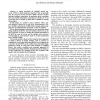Free Online Productivity Tools
i2Speak
i2Symbol
i2OCR
iTex2Img
iWeb2Print
iWeb2Shot
i2Type
iPdf2Split
iPdf2Merge
i2Bopomofo
i2Arabic
i2Style
i2Image
i2PDF
iLatex2Rtf
Sci2ools
TNN
2008
2008
A New Approach to Knowledge-Based Design of Recurrent Neural Networks
Abstract-- A major drawback of artificial neural networks (ANNs) is their black-box character. This is especially true for recurrent neural networks (RNNs) because of their intricate feedback connections. In particular, given a problem and some initial information concerning its solution, it is not at all clear how to design an RNN that is suitable for solving this problem. In this paper, we consider a fuzzy rule-base with a special structure, referred to as the fuzzy all-permutations rulebase (FARB). Inferring the FARB yields an input-output mapping that is mathematically equivalent to that of an RNN. We use this equivalence to develop two new knowledge-based design methods for RNNs. The first method, referred to as the direct approach, is based on stating the desired functioning of the RNN in terms of several sets of symbolic rules, each one corresponding to a sub-network. Each set is then transformed into a suitable FARB. The second method is based on first using the direct approach...
| Added | 15 Dec 2010 |
| Updated | 15 Dec 2010 |
| Type | Journal |
| Year | 2008 |
| Where | TNN |
| Authors | Eyal Kolman, Michael Margaliot |
Comments (0)

